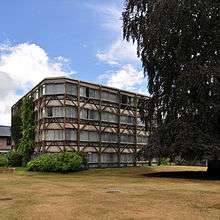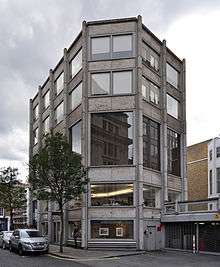Alison and Peter Smithson

English architects Alison Smithson (22 June 1928 – 14 August 1993) and Peter Smithson (18 September 1923 – 3 March 2003) together formed an architectural partnership, and are often associated with the New Brutalism (especially in architectural and urban theory).[1][2]
Peter was born in Stockton-on-Tees in north-east England, and Alison was born in Sheffield, South Yorkshire. They met while studying architecture at Durham University and married in 1949. Together, they joined the architecture department of the London County Council before establishing their own partnership in 1950.
Studies
Peter Smithson studied architecture at the University of Durham between 1939 and 1948, along with a programme in the Department of Town Planning, also at Durham, between 1946 and 1948. Alison studied architecture at the same university between 1944 and 1949. [3]
Work

They first came to prominence with Hunstanton School which used some of the language of high modernist Ludwig Mies van der Rohe but in a stripped back way, with rough finishes and deliberate lack of refinement. They are arguably among the leaders of the British school of New Brutalism. They were associated with Team X and its 1953 revolt against old Congrès International d'Architecture Moderne (CIAM) philosophies of high modernism.
Among their early contributions were streets in the sky in which traffic and pedestrian circulation were rigorously separated, a theme popular in the 1960s. They were members of the Independent Group participating in the 1953 Parallel of Life and Art exhibition at the Institute of Contemporary Arts and This Is Tomorrow in 1956. Throughout their career they published their work energetically, including their several unbuilt schemes, giving them a profile, at least among other architects, out of proportion to their relatively modest output.
His teaching activity included the participation for many years at the ILAUD workshops together with fellow architect Giancarlo De Carlo.
Built projects

Their built projects include:
- Smithdon High School, Hunstanton, Norfolk (1949–54; a Grade II* listed building)
- The House of the Future exhibition (at the 1956 Ideal Home Show)
- Sugden House, Watford
- The Economist Building, Piccadilly, London (1959–65)
- Garden building, St Hilda's College, Oxford (1968)
- Private house extension for Lord Kennet, Bayswater, London, 1960
- Robin Hood Gardens housing complex, Poplar, East London (1969–72)
- Buildings at the University of Bath, including the School of Architecture and Building Engineering (1988)
- The last project the Cantilever-Chair Museum of the Bauhaus design company TECTA in Lauenfoerde, Germany
Robin Hood Gardens was a project under construction when B. S. Johnson made a short film about the couple for the BBC, The Smithsons on Housing (1970). Sukhdev Sandhu, in a blog entry for the London Telegraph website wrote that "they drone in self-pitying fashion about vandals and local naysayers to such an extent that any traces of visionary utopianism are extinguished."[4] The finished flats suffered from high costs associated with the system selected and high levels of crime, all of which undermined the modernist vision of streets in the sky and the Smithsons' architectural reputation.[5]
They would go on to design several buildings at Bath, while relying mainly on private overseas commissions and Peter Smithson’s writing and teaching (he was a visiting professor at Bath from 1978 to 1990, and also a unit master at the Architectural Association School of Architecture).
Unbuilt proposals

Their unbuilt schemes Include:
- Coventry Cathedral unsuccessful competition entry, 1951
- Golden Lane Estate unsuccessful competition entry, 1952
- Sheffield University, unsuccessful competition entry
- Hauptstadt, unsuccessful competition entry, 1957
- British Embassy, Brasília, Competition winning design, unbuilt due to financial constraints, 1961
References
- ↑ Alison and Peter Smithson, Design Museum
- ↑ Peter & Alison Smithson - Open University
- ↑ Smithson, Peter and Alison. 2001. pg.19–20
- ↑ Sukhdev Sandhu "You're Human Like The Rest Of Them – the NFT's celebration of BS Johnson", telegraph.co.uk, 16 June 2009.
- ↑ Alison and Peter Smithson, Design Museum.
Sources
- Smithon, Alison and Peter (2001). The Charged Void: Architecture. New York, New York: Monacelli Press, Inc. ISBN 1-58093-050-6.
|